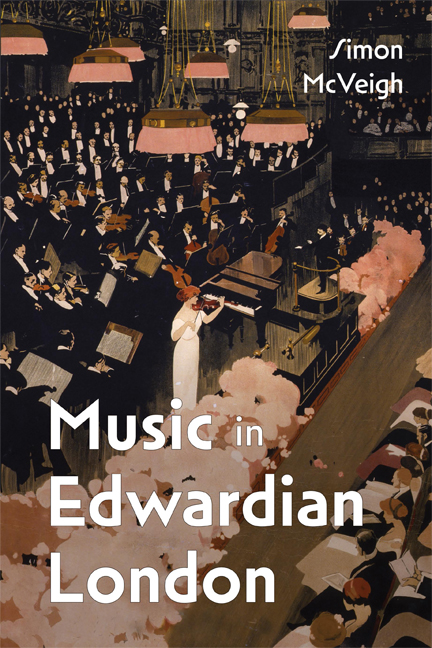Book contents
- Frontmatter
- Dedication
- Contents
- List of Illustrations
- Preface
- 1 Edwardian Soundscapes
- 2 Mapping a Musical City: Place (and Class)
- 3 Mapping a Musical City: Time (and Taste)
- 4 London as Musical Hub: Europe, America, Empire
- 5 The British Question
- 6 Britain and ‘Others’
- 7 Hidden Voices
- 8 From Battersea to Bermondsey: Suburban Music and Local Politics
- 9 London’s Music: An Overview
- Sources and Bibliography
- Index
- Miscellaneous Endmatter
4 - London as Musical Hub: Europe, America, Empire
Published online by Cambridge University Press: 09 May 2024
- Frontmatter
- Dedication
- Contents
- List of Illustrations
- Preface
- 1 Edwardian Soundscapes
- 2 Mapping a Musical City: Place (and Class)
- 3 Mapping a Musical City: Time (and Taste)
- 4 London as Musical Hub: Europe, America, Empire
- 5 The British Question
- 6 Britain and ‘Others’
- 7 Hidden Voices
- 8 From Battersea to Bermondsey: Suburban Music and Local Politics
- 9 London’s Music: An Overview
- Sources and Bibliography
- Index
- Miscellaneous Endmatter
Summary
BRITAIN's PLACE IN THE world, and London's in particular, underpins much of this book. Of course, it was a tense period in British history, with rising militarism in Germany, social upheavals in Russia, unease in Ireland, and the relentless pressures of a seemingly ever-expanding empire – while the very concept of internationalism had become tainted with the supposed disloyalty of the liberal ‘pro-Boer’ faction.
And yet, to quote Grace Brockington on the arts more broadly: ‘The prospect of European fragmentation stimulated a counter-movement toward international cooperation before the First World War.’1 One aspect of cosmopolitanism was simply the confluence of different nationalities in London's musical life. Certainly, the ‘ultra-modern’ label was routinely attached to a hugely divergent group – from Richard Strauss, Debussy and Ravel to Stravinsky and Schoenberg, not forgetting the native-born Holbrooke and Scott. In terms of public perception, this ultra-modern connection often trumped nationality. It can even be argued that the very concept of national schools had effectively run its course.
But not everyone bought into this agenda. Cosmopolitanism itself was subject to deeply-held British suspicion, not least because of its centuries-old links with a social elite. While foreign music certainly possessed an exotic allure, it could also seem vaguely threatening, especially if it transgressed sexual, religious or psychological boundaries. Such entrenched reservations were inevitably reinforced by the nationalist agenda permeating popular culture.
These competing attitudes reinforce a paradox in Edwardian music reception. Island Britain seemed intent upon maintaining its separate, even isolationist, musical culture, securely rooted in its Victorian past. Yet British consumers simultaneously relished a share in the scintillating cross-currents emerging from Paris, Vienna and beyond. How these contrasting perspectives collided and came together will be the subject of the next two chapters.
❧ Free Trade
Questions of musical identity were closely related to Britain's identity as a trading nation – and with British liberals’ enduring belief in the moral rightness of free trade. For those in their camp, it was unthinkable to erect barriers against the finest music and musicians from abroad purely to protect the interests of British challengers.
- Type
- Chapter
- Information
- Music in Edwardian London , pp. 100 - 136Publisher: Boydell & BrewerPrint publication year: 2024

